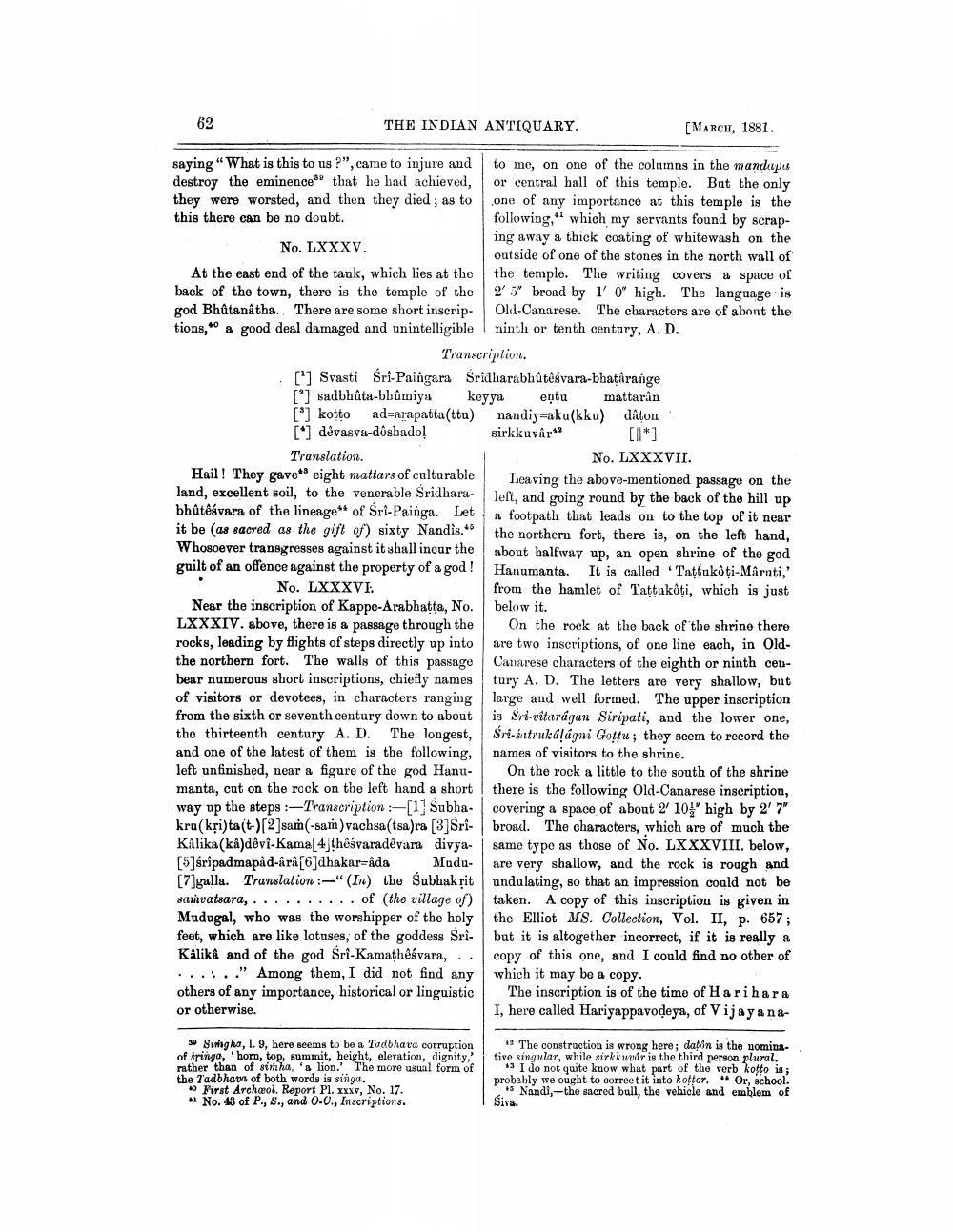________________
62
THE INDIAN ANTIQUARY.
[MARCII, 1881.
saying "What is this to us?", came to injure and to me, on one of the columns in the mandupu destroy the eminence that he had achieved, or central ball of this temple. But the only they were worsted, and then they died; as to one of any importance at this temple is the this there can be no doubt.
following," which my servants found by scrap
ing away a thick coating of whitewash on the No. LXXXV.
outside of one of the stones in the north wall of At the east end of the tank, which lies at the the temple. The writing covers a space of back of the town, there is the temple of the 25" broad by 1' 0" high. The language is god Bhutanatha. There are some short inscrip- Old-Canarese. The characters are of abont the tions," a good deal damaged and unintelligible | ninth or tenth century, A. D.
Transcription. ['] Svasti Sri-Paingara Sridharabhûtésvara-bhatárange [*] sadbhuta-bbûniya keyya entu mattaran [*] kotto ad=rrapatta(ttu) nandiy-aku(kku) daton [*] dévasva-dôshado! sirkkuvâr** [*] Translation.
No. LXXXVII. Hail! They gave*s eight mattars of culturable
| Leaving the above-mentioned passage on the land, excellent soil, to the venerable Sridhara- left, and going round by the back of the hill up bhûtésvara of the lineage of Sri-Painga. Let a footpath that leads on to the top of it near it be (as sacred as the gift of sixty Nandis." the northern fort, there is, on the left hand, Whosoever transgresses against it shall incur the
about halfway up, an open shrine of the god guilt of an offence against the property of a god! Hanumanta. It is called "Tattukoti-Maruti,' No. LXXXVI:
from the hamlet of Tattukoti, which is just Near the inscription of Kappe-Arabhatta, No. below it. LXXXIV. above, there is a passage through the On the rock at the back of the shrino there rocks, leading by flights of steps directly up into are two inscriptions, of one line each, in Oldthe northern fort. The walls of this passage Canarese characters of the eighth or ninth cenbear numerous short inscriptions, chiefly names tury A. D. The letters are very shallow, but of visitors or devotees, in characters ranging large and well formed. The upper inscription from the sixth or seventh century down to about is SH-vitarágan Siripati, and the lower one, the thirteenth century A. D. The longest, Sri-sutrukálágni Gottu; they seem to record the and one of the latest of them is the following, names of visitors to the shrine. left unfinished, near a figure of the god Hanu- On the rock a little to the south of the shrine manta, cut on the rock on the left hand a short there is the following Old-Canarese inscription, way up the steps :-Transcription :-[1] Subha- covering a space of about 2 10 high by 2' 7" kru(kļi)tait-)[2]sam(-sam) vachsatsa)ra [3]Sri- broad. The characters, which are of much the Kalika (ka)dêvî-Kama[4]theśvaradevara divya- same type as those of No. LXXXVIII. below, [5]sripadmapad-ârâ[6]dhakar-âda Madu- are very shallow, and the rock is rough and [7]galla. Translation :-"(In) the Subhak rit undulating, so that an impression could not be savatsara, .......... of (the village of) taken. A copy of this inscription is given in Mudugal, who was the worshipper of the holy the Elliot MS. Collection, Vol. II, p. 657; feet, which are like lotuses, of the goddess Sri- but it is altogether incorrect, if it is really a Kalikâ and of the god Sri-Kamatheśvara,.. copy of this one, and I could find no other of :....." Among them, I did not find any which it may be a copy. others of any importance, historical or linguistic The inscription is of the time of Harihara or otherwise.
I, here called Hariyappavodeya, of Vijaya na
3° Singha, 1. 9, here seems to be a Tudbhava corruption of Sringa, 'horn, top, summit, height, elevation, dignity, rather than of sinha, 'a lion.' The more usual form of the 7adbhat of both words is singa. 40 First Archeol. Report Pl. xxxv, No. 17.
No. 43 of P., S., and 0-C., Inscriptions.
13 The construction is wrong here; dan is the nominative singular, while sirkkuvar is the third person plural.
13 I do not quite know what part of the verb kofto is; probably we ought to correct it into koftor. Or, school.
*5 Nandi,--the sacred bull, the vehicle and emblem of
Siva.




